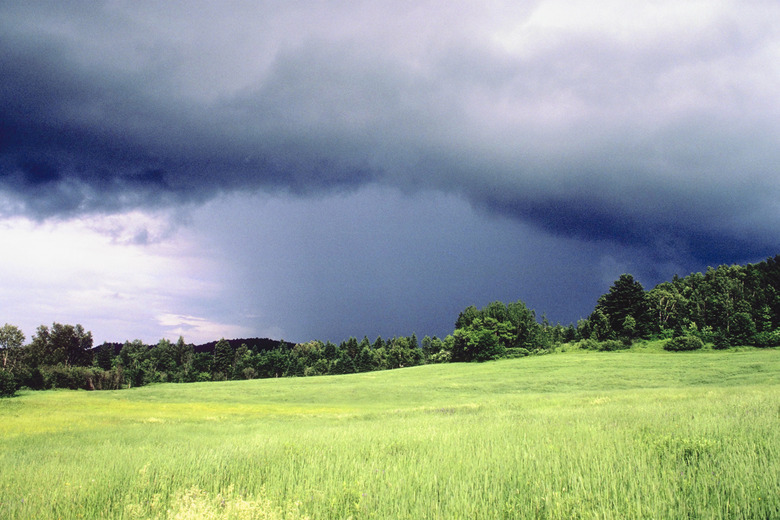The Three Types Of Weather Fronts
Weather fronts are the primary cause of meteorological activity because they are transition zones. These boundaries separate two masses of air with different temperatures, humidities and densities. There are several types of weather fronts. The type of front that forms depends on the direction of flow of the air mass and its characteristics. A frontal zone may be 20 to 100 miles in width, and there is definitely a marked contrast between conditions on the leading side and the rear side; this includes temperature differentials, dew point, wind direction, weather conditions and cloud cover.
Weather Fronts
The five major types of fronts (cold, warm, occluded, stationary and dry line phenomena) depend on the direction of the air mass's travel and its characteristics. When two different air masses collide, the warmer air rises above the colder, denser air. In the northern hemisphere, most fronts travel from west to east carrying clouds and rain. As a front passes through an area, changes in wind speed and direction, atmospheric pressure and moisture result.
TL;DR (Too Long; Didn't Read)
Weather front definition: A boundary separating two masses of air of different densities.
Cold Fronts
When cold air replaces warm air, a cold front results. As warm air rises and cools,its water vapor condenses with cloud formation. The rain resulting from cold fronts is short lived and heavy, generally affecting a distance of about 50 miles as the front moves on. Cold fronts blow over areas faster than other types of fronts, producing some of the most violent thunderstorms that move with the front while maintaining their intensity. They are often associated with a line of strong thunderstorms, a squall line, parallel to the front and moving ahead of it and leaving cooler weather behind with clear blue skies. On a weather map, the cold front symbol is usually a blue line with triangle pips pointed in the direction of the front's travel.
Warm Fronts
Warm fronts move more slowly and are less violent than cold fronts. They are associated with warm air moving over cold air and are more likely to produce large regions of light to moderate rain, drizzle or snow. Cirrus clouds and alto cumulus, along with fog, often precede warm fronts as they move through an area. The milder weather that follows will be warmer in temperature.
Occluded Fronts
The conditions of occluded fronts arise whenever cold, warm and cool air combine. There are two types of occluded fronts: cold and warm. The cold occluded front forms when a cold front overtakes a warm front. The warm front rises over the colder, which slowly creeps along the ground surface. The weather characterizes a warm front when the occlusion begins but gradually changes into a cold front with low temperatures and heavy rain.
The warm occluded front occurs when a cold front approaches a warm front layered over an extremely cold front. In this situation the cold and warm fronts rise and pass over the extremely cold front as it remains near ground level. The resulting weather pattern is similar to that of a passing warm front.
Stationary Fronts and Dry Lines
When warm and cold air masses meet and form a stationary boundary or front, there is no further movement from either one. Their characteristics are similar to warm fronts but stationary fronts are less active and eventually fade away.
A dry line is a frontal boundary separating hot, dry western air from warm, moist air in the east. They often occur during the spring in the plain states of the western U.S. and move east during the day. If the atmospheric instability in the warm air is strong enough, dry lines can spawn severe storms with tremendous winds, large hail and tornadoes.
Cite This Article
MLA
Evans, Diane. "The Three Types Of Weather Fronts" sciencing.com, https://www.sciencing.com/three-types-weather-fronts-8753719/. 20 July 2018.
APA
Evans, Diane. (2018, July 20). The Three Types Of Weather Fronts. sciencing.com. Retrieved from https://www.sciencing.com/three-types-weather-fronts-8753719/
Chicago
Evans, Diane. The Three Types Of Weather Fronts last modified March 24, 2022. https://www.sciencing.com/three-types-weather-fronts-8753719/
